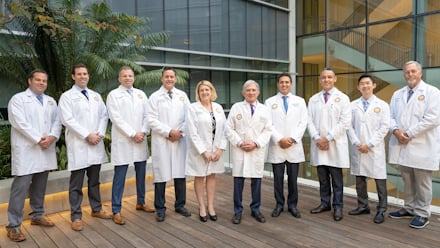Spinal Cord Injuries and Paralysis
UC San Diego Health offers a comprehensive program to help you restore function following a spinal cord injury.
Paralysis can result from a disease of the muscle, or from an injury to nerves, the spinal cord, or the brain. It can affect a small or large area, just one side of the body, and can be permanent or temporary.
Our physicians have expertise in restoring movement and function for individuals living with paralysis due to:
- Brain issues
- Spinal cord injury
- Nerve disorders
We also correct facial nerve disorders, restore function following a stroke, and enhance walking abilities. Learn more about treatments and procedures below.
Spinal Cord Injuries
Unlike the peripheral nerves, cells in the spinal cord do not regenerate after an injury. Damage to the spinal cord can impact body function, strength and sensation, causing loss of feeling, weakness and paralysis.
Spinal Cord Injury Surgery & Treatment
Recovering even partial arm and hand function after a spinal cord injury can have an enormous impact on independence and quality of life. Our surgeons use the latest surgical techniques and treatments to improve the level of functioning.
Surgical and nonsurgical treatment techniques we use:
Nerve transfer: Nerves with the best control are transferred to the most important muscle groups to improve function in that limb.
Tendon transfer: The most common procedure for restoring function. A tendon is moved from one point to another to improve joint function. Tendon transfers offer functional gains for an estimated 70 percent of tetraplegic patients.
Selective peripheral neurotomy: Nerves are trimmed to reduce spasticity.
Phrenic nerve stimulator: Patients dependent on a ventilator have the option of a surgically implanted phrenic nerve stimulator which frees them from ventilator dependency.
Spinal Cord Stimulation
Electrodes are placed in the space outside of the thick membrane that surrounds the spinal cord (the dura) to reduce pain and spasticity through nerve stimulation. It can also help with movement control.
How does spinal cord stimulation work?
Electrodes are strategically placed into the space outside of the dura (covering of spinal cord). These electrodes are connected to a small pulse generator placed under the skin.
The exact site of stimulation is critical for obtaining the desired effects.
Is spinal cord stimulation right for you?
To determine whether you are a candidate for epidural spinal cord stimulation, you will first undergo trial stimulator placement.
A trial stimulator placement involves the insertion of an electrode (using a needle and local anesthesia). This simple procedure is done in an outpatient setting. Once the electrode is inserted, you will begin treadmill training with a body-weight support system (to help restore a more natural gait pattern), and be given a generator to carry for one week.
If the results are positive, our team will proceed with the surgical placement of a paddle lead. Paddle leads offer more precise stimulation to targeted nerves and can activate the most ideal parts of the spinal cord. Unlike wire leads, which can move out of place over time, paddle leads are designed for long-term placement.
Phrenic Nerve Pacer
A phrenic nerve pacer is an implantable device that provides ventilatory support for people who have lost the ability to breathe independently due to a condition such as sleep apnea or injury such as spinal cord injury.
An electrode and receiver are surgically implanted (electrode placed on the phrenic nerve and receiver just under the skin) and an external antenna and transmitter are worn on top of the skin.
How Does It Work?
Radiofrequency energy from the transmitter is converted into pulses and sent to the electrode, causing the diaphragm to contract. The result is a breathing pattern that’s more natural than a mechanical ventilator.
Benefits Over Mechanical Ventilator
Some people who have a high spinal cord injury (damage to the phrenic nerve) will require a ventilator to help them breathe.
Those who don't want to be dependent on a ventilator have the option of a surgically implanted phrenic nerve simulator.
Advantages of phrenic nerve stimulators over mechanical ventilators:
- Allows normal speech and breathing
- Makes eating and drinking easier
- Small and unobtrusive
- Implants are made to last a lifetime
- Cost-effective
Level of Spinal Cord Injury: Restoring Function
| Spinal Cord Injury Levels | Function We Restore at UC San Diego Health For Specific Spinal Injuries |
|---|---|
| C1-C3 | Breathing using phrenic nerve pacer or ventilator. |
| C3-C4 | Basic arm function (elbow flexion) using a nerve transfer. |
| C5-C6 | Grasp and release function, and triceps function |
| C7-C8 | More sophisticated grasp and release and finer hand movements. |
| T1 | Intrinsic balance to the hands. |
| T2-T9 | Sensation to lower extremities via nerve transfer. Possibility of improving lower extremity function using spinal cord stimulation.* |
| T10-T12 | Some hip movement and extension as well as sensation to proximal legs. |
| L1-L2 | Hip extension with a nerve transfer (nerve transfer only used for those with some hip movement). |
| L3-L4 | Improved walking with a nerve transfer (transfers only used in those who have some hip flexion and knee extension). |
| L5-S1 | Ankle stability via a nerve or tendon transfer. |
*NOTE: All patients with some movement in lower extremities may be considered as candidates for epidural stimulation to improve movement or reduce spasms.
Using epidural spinal cord stimulation, we can improve standing and walking in people who have cervical and thoracic level injury.


